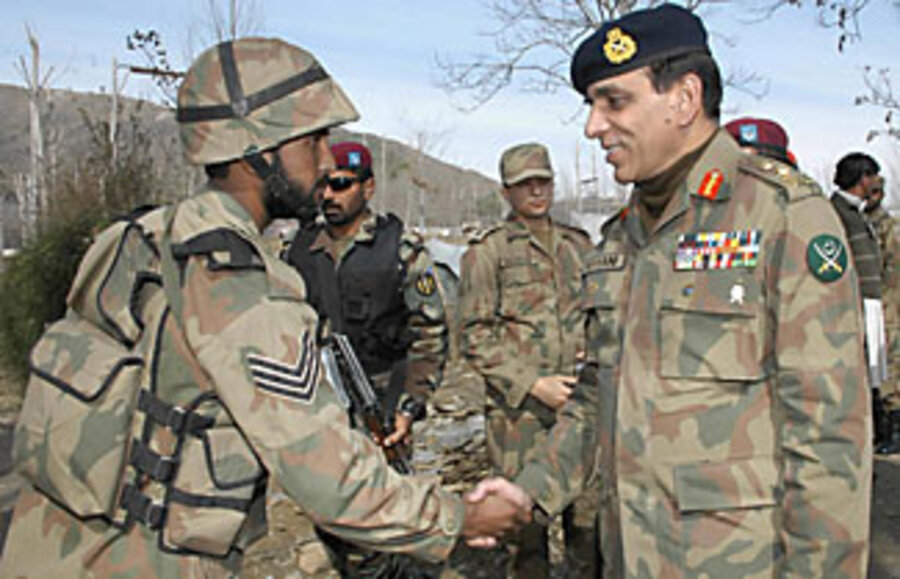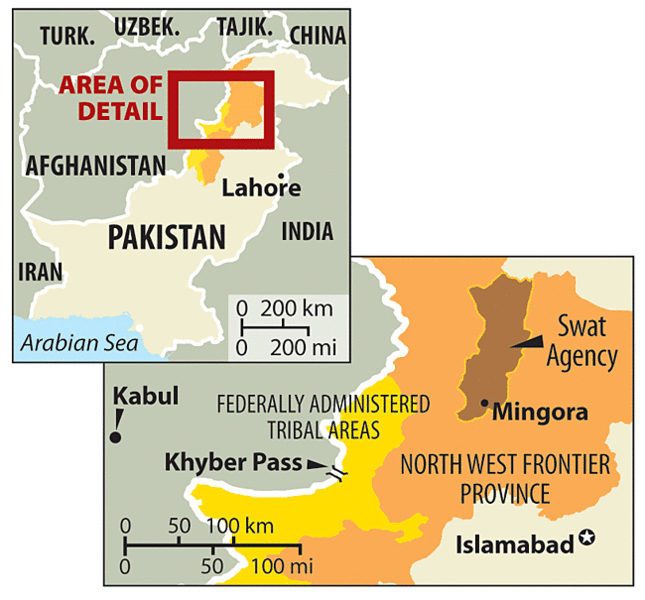Pakistan tackles Swat, a key militant area
Loading...
| Lahore, Pakistan
The Pakistani Army's renewed effort to reclaim control of the Swat Valley – a tourist idyll taken over by ultraconservative militants allied with the Taliban – has taken on symbolic importance in the country's fight against a growing insurgency.
The Army launched fresh operations in Swat Wednesday, as Army Chief Gen. Ashfaq Kayani vowed to retake the troubled region following growing criticism over what analysts and human rights groups are calling the complete loss of government control. By the estimates of residents and local officials, up to 80 percent of Swat is now under militant control.
Unlike the northwestern Federally Administered Tribal Areas, where militants also hold sway, Swat falls in the "settled areas" of Pakistan.
The strategic significance of the Swat Valley is difficult to underplay, says Badar Alam, a senior editor for Pakistan's Herald magazine. "If it falls to the Taliban, despite not being geographically linked to Afghanistan – it will send the message they can claim victory in part of the NWFP [Northwest Frontier Province], if not the country."
Since 2007 the military has waged an on-and-off offensive in Swat that has failed to contain militants. Instead, they have established a "parallel administration" and sharia courts, and carry out political killings and attacks on girls' schools, which they oppose.
'Reign of terror'
In light of a renewed Army offensive, residents say they feel trapped. "People here are terrified at the thought of another massive military operation," says Hafiz Khan, a father of three who runs a computer business in Mingora, a major town in the district. But, he says, it's either that or allow the Pakistani Taliban to continue their reign of terror.
Within 100 miles of the capital Islamabad, Swat was until recent yearsa thriving tourist venue renowned for its lush forests, clear rivers, and ski resorts. But since their resurgence last September, militias led by Maulana Fazlullah have conducted brutal killings of political foes and those deemed "immoral." On Sunday, 43 people – including former and present ministers – were added to the hit list, which is read on the radio. Almost all of the politicians named have since fled.
Headless bodies are strung up daily in a public area residents now call Khooni Chowk ("bloody intersection"), for sins ranging from non-adherence to dress codes to defiance of the militants' regime, says Niaz Ali Khan, a student from Mingora who studies in Swat.
"Women are being killed there on the basis of something less than a doubt about their character," he adds, noting that a similar fate befell a female cousin of his.
One of the most cited examples by residents is that of Pir Samiullah, a pro-government loyalist who was killed in crossfire with Swat militants on Dec. 13. His body was later exhumed from its grave and strung up in a public place as a warning to others.
The militants also made it their mission to destroy nearly 200 schools, most of them for girls. On Dec. 24, an edict was issued to parents: Stop sending your daughters to school.
"My business is keeping me here, but we're feeling trapped now. I want an education for my girls, but it's just not possible now," says one Swat resident.
Army's absence
Maj. Gen. Athar Abbas, a spokesman for the Pakistani Army, blames the current situation on militants' failing to heed a cease-fire made with the government last May.
The lack of an Army presence created a power vacuum, which allowed militants to reestablish themselves, he says. "They regrouped and returned with a vengeance. During the vacuum they 'sorted out' all those who had reached out to the military," he says.
"We're now taking a more proactive role, and the situation should be clearer by March," he adds. The girls' schools, he says, will reopen once the Army has reestablished control of the area.
Such words are met with skepticism by the Human Rights Commission of Pakistan, an independent organization that conducted extensive field work in Swat Valley late last year. "The local population has been displaced," notes Mehdi Hassan, vice-chairperson of the HRCP.
Of particular concern to all is the ongoing transmission of an illegal FM radio station which Mr. Fazlullah and his followers use to broadcast religious sermons as well as a daily hit list.
This "appalling inability to even jam a radio station" is evidence of the Army's unwillingness to act, says Mr. Hassan.
According to Hameedullah Khan, a reporter for the English daily Dawn whose family home was destroyed by militants earlier this month, a common perception in the area is that the Army is guilty of "cowardice or collusion."
More than 12,000 troops are fighting 2,000 to 3,000 militants, he points out. He also blames the provincial government for not making up its mind on whether to cut deals with the militants or crack down on them, and believes this may have tempered the Army's willingness to fight.
Militants are now "in every house and in every street corner. The military would now need to flatten the whole city to get rid of them," he continues.
"Things should never have gone this far ... the whole area could have been clear of militants by now," says Bahadar Khan, a watchman who splits his time between Lahore and Mingora, where his wife and children remain.
"Now the ordinary people who are stuck in the crossfire will suffer most," he says.






